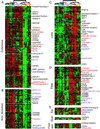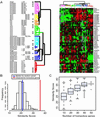Diversity, topographic differentiation, and positional memory in human fibroblasts
- PMID: 12297622
- PMCID: PMC130553
- DOI: 10.1073/pnas.162488599
Diversity, topographic differentiation, and positional memory in human fibroblasts
Abstract
A fundamental feature of the architecture and functional design of vertebrate animals is a stroma, composed of extracellular matrix and mesenchymal cells, which provides a structural scaffold and conduit for blood and lymphatic vessels, nerves, and leukocytes. Reciprocal interactions between mesenchymal and epithelial cells are known to play a critical role in orchestrating the development and morphogenesis of tissues and organs, but the roles played by specific stromal cells in controlling the design and function of tissues remain poorly understood. The principal cells of stromal tissue are called fibroblasts, a catch-all designation that belies their diversity. We characterized genome-wide patterns of gene expression in cultured fetal and adult human fibroblasts derived from skin at different anatomical sites. Fibroblasts from each site displayed distinct and characteristic transcriptional patterns, suggesting that fibroblasts at different locations in the body should be considered distinct differentiated cell types. Notable groups of differentially expressed genes included some implicated in extracellular matrix synthesis, lipid metabolism, and cell signaling pathways that control proliferation, cell migration, and fate determination. Several genes implicated in genetic diseases were found to be expressed in fibroblasts in an anatomic pattern that paralleled the phenotypic defects. Finally, adult fibroblasts maintained key features of HOX gene expression patterns established during embryogenesis, suggesting that HOX genes may direct topographic differentiation and underlie the detailed positional memory in fibroblasts.
Figures





References
-
- Dhouailly D. In: Pattern Formation. Malincinski G, Bryant S, editors. New York: Macmillan; 1984. pp. 581–601.
-
- Yamaguchi Y, Itami S, Tarutani M, Hosokawa K, Miura H, Yoshikawa K. J Invest Dermatol. 1999;112:483–488. - PubMed
-
- Alizadeh A A, Eisen M B, Davis R E, Ma C, Lossos I S, Rosenwald A, Boldrick J C, Sabet H, Tran T, Yu X, et al. Nature (London) 2000;403:503–511. - PubMed
-
- Perou C M, Sorlie T, Eisen M B, van de Rijn M, Jeffrey S S, Rees C A, Pollack J R, Ross D T, Johnsen H, Akslen L A, et al. Nature (London) 2000;406:747–752. - PubMed
-
- Normand J, Karasek M A. In Vitro Cell Dev Biol Anim. 1995;31:447–455. - PubMed
Publication types
MeSH terms
Substances
LinkOut - more resources
Full Text Sources
Other Literature Sources
Molecular Biology Databases
Research Materials

